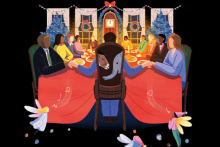Christmas
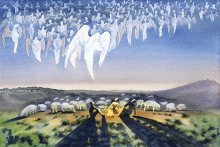
I’VE HEARD A very old story about Christmas: When Adam and Eve were in the garden, they often sang with the angels, the most perfect sound ever created. When they were banished, the song fractured. Neither choir—human nor angelic—could sing perfect praises to the Creator of the universe alone.
On Christmas, however, a miracle occurs. The heavenly hosts reunite with mortal shepherds—the band is back together, the choir again complete. At least for a day, heaven and earth are reconciled in song.
Why is this memory of the Nativity important for us now?
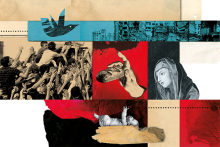
FOR THE THIRD year in a row, Advent in Palestine is not a season of joy. Even with the tenuous ceasefire, Advent is lived in the shadow of genocide, walls, checkpoints, ethnic cleansing, dispossession, and fear.
For many Palestinians, these days of waiting and preparation are overshadowed by mourning for loved ones lost, for homes demolished, for lands taken. In Bethlehem itself, where the Christian story began, streets that should be filled with song and light are burdened with grief and lament. The hymns of waiting mingle with the cries of the bereaved, displaced, imprisoned, and the starving.
In the land where the gospel of Jesus first unfolded, the nearness of Advent is most real. The Christmas story doesn’t look like comfort, plenty, and “toys in every store.” The original narrative bears a much closer resemblance to the times in which we, Palestinians, currently live.
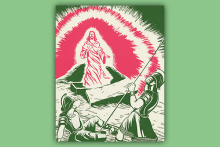
I WANT TO let you in on a joke. But, for many of us, this joke might not be funny for a very long time. Let’s begin by addressing the elephant in the room. The election results drastically exacerbated tensions that Americans have been struggling with for the last decade. As I write, holiday plans are being made and canceled based on who voted for whom. This tension is not going away soon. However, changes of political regimes and the Christmas story give us insight into where we are as followers of Jesus today.
As a pastor and a comedian, I try to bring God’s levity to bear on tragedy to recenter a Christian perspective. At its root, the word levity means “lightness,” like the word “levitate.” While God’s levity may not be conventionally funny in the moment, it employs the elements of comedy that, by design, lighten the burdens of our human experience.

In my favorite home video ever, it’s 2020 and my kids are opening their Christmas morning gifts while wearing new ski jackets, even though it was 75 degrees in South Texas, where we live. My son’s 4-year-old hands are still pudgy, and he hasn’t learned to glide his “l” sounds yet, so his raspy morning voice is extra adorable. As he unwraps his gifts, he shouts and cheers and stares at some Power Rangers in adoration.
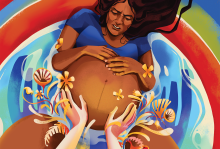
A LOT OF BEGGING happens at Christmas. There are pleas in the toy aisle and hints left open on laptops. But no one begs to be in labor. Not even a woman who is pregnant. Unless, of course, she is at the bitter end of her pregnancy.
In the language of King James, Luke tells us that Mary is not just pregnant, but she is “great with child” (Luke 2:5). She is on the cusp of birthing, of being the first one to slide her hands up under the armpits of the warm, slippery flesh of God. No one before or after will have God in quite this way.
In Mary, the Word became flesh and was born in the most mundane, most primal human act. This flesh must count for something. The extremely pregnant body of Mary — great with child — reveals the nature of our waiting for Christ and what it might mean to cry out for Jesus’ coming.

My first experiences of Christian sacraments, including baptism and the Eucharist, were mysterious and somewhat confusing. As a Catholic little girl, I didn’t remember my infant baptism and could never quite wrap my head around eating Jesus’ flesh and drinking his blood. What’s more, these solemn events happened within the confines of a giant, cavernous church — a place where I had to be still, quiet, and serious. During weekly Mass, I learned implicitly from the nuns that reverence and fun do not go together.
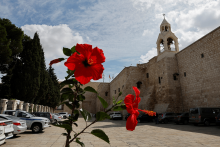
At a vigil for peace in Washington, D.C., this Tuesday, Palestinian Lutheran pastor Munther Isaac spoke about the approaching Christmas season in his home of Bethlehem in the West Bank.
“How can we celebrate when we feel this war — this genocide — that is taking place could resume at any moment?” he said.
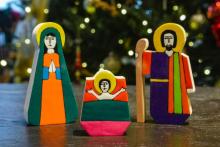
The following is an act of imagination. It is an attempt to fill in the gaps that are left for us in this story to bring the text to life. My hope is that this could be used as a resource for family Christmas Eve devotions or for congregations looking to creatively imagine the birth of Christ.

When the biblical writers penned words about the “creator of the heavens and the earth,” they didn’t have the faintest idea of what they were really saying. Yet Christian faith asserts the power that created galaxies full of black holes and dark energy is the same power that became mysteriously embedded in the uterus of a poor teenage girl in a forsaken village in present-day Palestine. The first chapter of the gospel of John describes Jesus’ arrival this way: “All things came into being through him, and without him not one thing came into being” (1:3). That defies all boundaries of rationality.

The 1992 classic is full of wonders you can’t find anywhere else: Michael Caine starring in a children’s movie, a ghost of Christmas future that haunts me every time I consider splurging on frivolities, and a drum set at a Victorian England Christmas party. But the movie isn’t just a fun, Muppet-y take on Charles Dickens’ classic novella; it’s also a compelling screenplay with heart-warming, humorous songs that offer a radical Christmas message of “cast down the mighty … send the rich away empty.”

A FEW YEARS ago, I set out to knit a baby blanket as an Advent prayer practice. Knitting is incredibly meditative and allows me to pray with focus and clarity. Knitting a baby blanket seems appropriate as the church awaits the arrival of the “newborn king.” I wish I could say I finished the blanket in time for Christmas. I did not. However, even that seems appropriate, as so much remains unresolved for Jesus’ community at his birth. Their political occupation continued, and even Jesus’ birth story reflects the impositions placed upon his family by the Roman Empire. God’s inbreaking happens under serious duress — but it happens nonetheless.
My favorite lines from the poem “Christmas is Waiting to be Born” by Howard Thurman are: “Where fear companions each day’s life, / And Perfect Love seems long delayed. / CHRISTMAS IS WAITING TO BE BORN: / In you, in me, in all [hu]mankind.”
Thurman reminds us that God was born into our sorrow and among those who are brokenhearted and struggling. That truth is so important to hold on to as we process years of our own collective trauma. No matter how unresolved things are, Christmas is born in us, too! In December we continue our journey through Advent and arrive at Christmas. We might not have received what we’re waiting for by that time, and very little may make sense. Yet, because of who God is, we open our hearts to the improbable, trusting that we won’t be put to shame.

IN THE EIGHTH season of Call the Midwife, set in post-war east London, nuns and nurse midwives of Nonnatus House assist a woman with severe complications from a “backstreet” abortion. Sister Julienne says to a young nurse, “The word ‘midwife’ means ‘with-woman.’ A woman in that situation needs somebody by her side.”
I’m pro-choice, which was an unpopular stance in the Catholic community I grew up in. For my views on reproductive rights, people in youth group called me a “baby killer” and “Pontius Pilate.” During Advent, specifically, I loathed the hollow teachings on Mary and childbirth. We sanitized the Nativity into a cute story — the equivalent of a Disney movie featuring a white family and a manger crowded with men. Only recently did I learn that some scholars believe that midwives attended Jesus’ birth. As reproductive freedom and care are further undermined in the United States, this is an apt time to reclaim a more feminist view of the Nativity and rethink Advent as the season of the midwife.

Activist Vanessa Nakate on Jesus, erasure, and the climate crisis in the Horn of Africa.

What rekindles our worship and wonder, causing us to reflect and repent, prompting us to hope and rejoice in this particular season of Advent? Perhaps the same spirit that moved abolitionists, advocates, and allies to pen our favorite holiday hymns can remind us of our reasons to rejoice.

Spencer is the ultimate I-won’t-be-home-for-Christmas film. It is Black Swan meets Jackie meets (to a far lesser degree) the The Family Stone. Which feels poignant in 2021, a year in which many of us are afraid to go home. The omicron variant will undoubtedly keep some of us away from our families. But others who can travel home for Christmas may feel anxious about the prospect of returning to houses divided by politics, theology, misinformation, or all three.

We long for Silent Night in crowded pews, by candlelight.
May we who stay at home now find your Christmas blessing.

I don’t live with the illusion that the holidays are cheery for everyone. Many of us find ourselves interacting with family and friends who do not have the same values we do. Here are four tips for navigating difficult relationships over the holidays — without compromising on dignity.

So as we participate in Advent this month, the Old Testament story of Job may be a helpful text to explore. Job addresses the enigma of suffering head-on, mincing no words but also not really answering the question of why we suffer. Perhaps, though, the simple freedom to question God and mourn our losses is just what we need this Christmas.

Though Thanksgiving 2020 isn’t canceled—like just about everything else this past year—it needs to be different. Because of this, it is currently not safe to travel or gather in the ways many of us typically do. This need to do differently has left many Christians split and pitted against one another.
